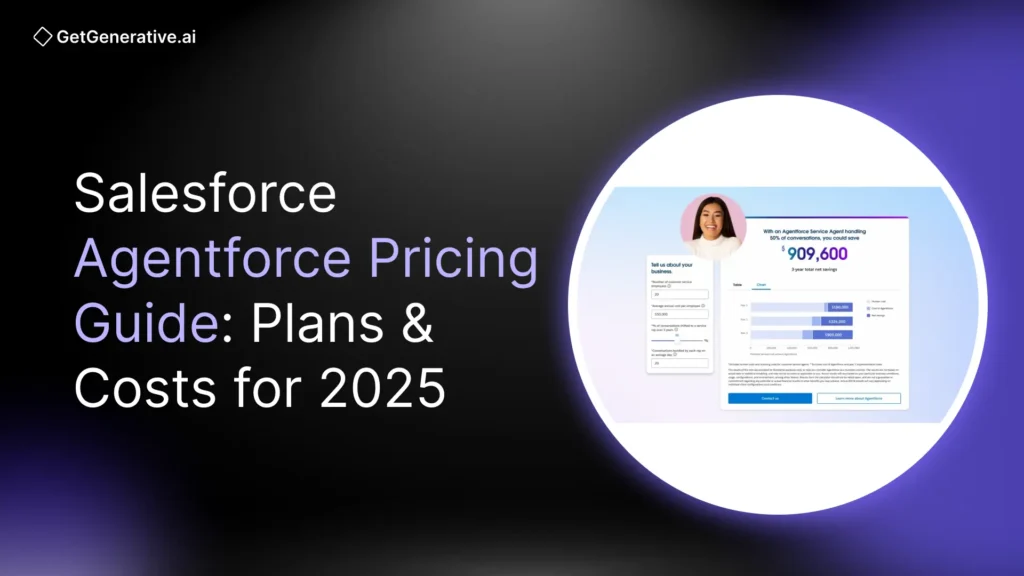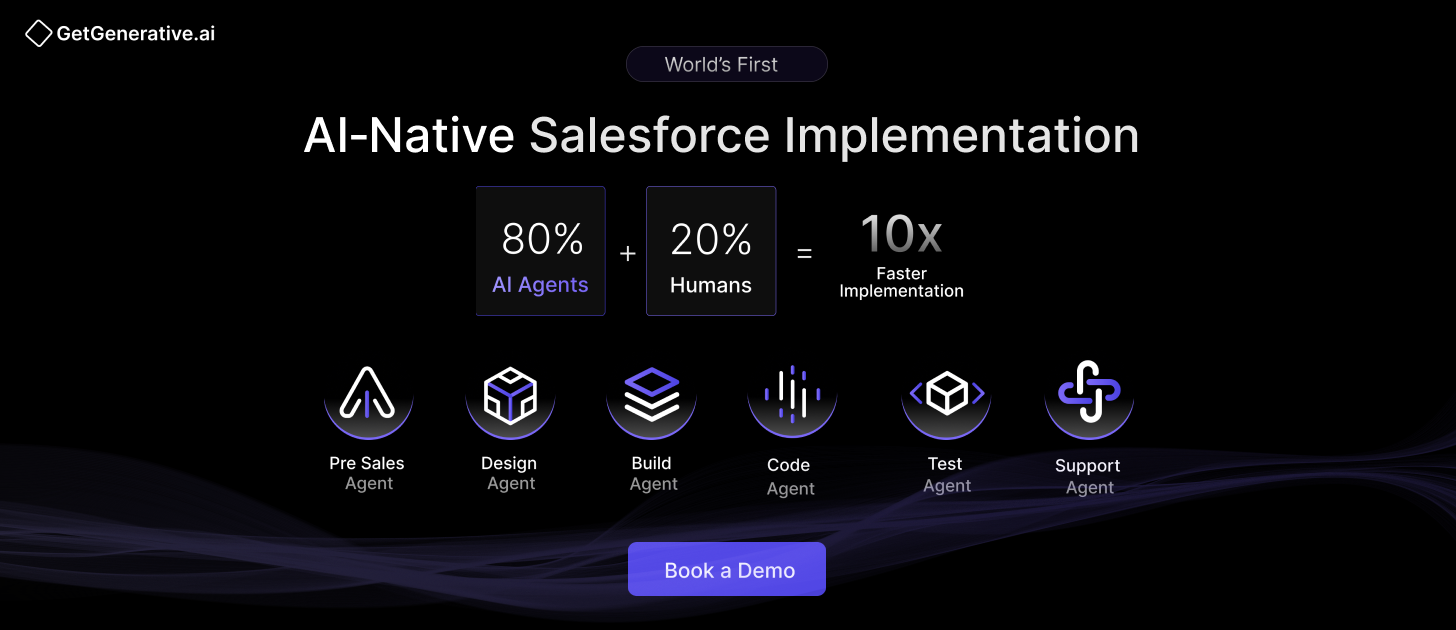Salesforce Agentforce Pricing Guide: Plans & Costs for 2025
Salesforce Agentforce has quickly become one of the most talked-about innovations in enterprise AI, transforming how organizations think about automation and digital labor. With 8,000+ customers already onboard and $900 million in AI and Data Cloud revenue within just six months of launch, Agentforce signals a major shift from traditional software licensing toward outcome-based AI investment.
Yet, beneath this impressive growth lies a complex pricing structure that CIOs and enterprise leaders must navigate carefully. A recent Salesforce CIO AI Trends study revealed that 90% of CIOs believe managing AI costs limits their ability to maximize value. In response, Salesforce has rolled out multiple pricing models in 2025—from per-user licensing to consumption-based Flex Credits—creating both opportunities and challenges for buyers.
This blog breaks down Agentforce’s pricing in detail, explains the hidden costs, and compares it against alternatives like Microsoft Copilot and OpenAI Enterprise.
Understanding Agentforce’s Revolutionary Pricing Evolution
The Shift from Conversations to Actions
When Agentforce launched, Salesforce adopted a $2 per conversation pricing model. While simple, it failed to account for enterprise workflows where a single query could trigger multiple backend processes.
To address this, Salesforce introduced Flex Credits in May 2025, charging $0.10 per action. Each action consumes 20 Flex Credits, with packages sold at $500 for 100,000 credits. Unlike conversation-based pricing, this action-based model ties costs directly to real business outcomes, ensuring organizations pay only for the actual work AI agents perform.
Three Payment Models to Fit Different Needs
Salesforce unveiled three distinct pricing models, recognizing that enterprises vary in maturity and AI adoption patterns:
- Pay-as-you-go – Best for pilots and unpredictable workloads. Companies pay monthly for actual Flex Credit usage, ensuring maximum flexibility.
- Pre-commit – Offers discounted rates in exchange for upfront commitments, ideal for enterprises with predictable AI usage.
- Pre-purchase – The most cost-effective option for high-volume users, letting organizations buy credits in bulk and use them over time.
This tiered structure allows enterprises to match their investment strategy with business certainty and scalability goals.
Also Read – Salesforce Agentforce Limitations You Should Know in 2025
Comprehensive Pricing Structure Breakdown
Standard Add-ons: The Foundation Layer
At the heart of Agentforce pricing are standard add-ons at $125 per user/month. These cover Agentforce for Sales, Service, and Field Service, including unlimited employee-facing agent usage inside Salesforce.
Compared to building AI solutions in-house, which takes 6–12 months, Agentforce can be deployed in just 4–6 weeks. This speed translates into faster ROI, with early adopters reporting measurable value within weeks.
Premium Industry Solutions: Vertical Specialization
For organizations in highly regulated industries, Salesforce offers premium add-ons at $150 per user/month. These include solutions for:
- Financial Services Cloud – with built-in compliance and risk management.
- Health Cloud – with HIPAA-ready AI agents trained on medical terminology.
- Manufacturing Cloud – optimized for industry-specific workflows.
The 20% markup reflects specialized compliance, workflows, and integrations that would otherwise be costly to build independently.
Public Sector Pricing: Maximum Compliance & Security
At the high end, Agentforce for Public Sector is priced at $650 per user/month. This reflects the stringent security measures required for government adoption, including FedRAMP High authorization and advanced compliance monitoring.
A case in point: City of Kyle, Texas, adopted Agentforce for citizen services, compliance checks, and recruitment workflows—showing how government entities can leverage autonomous AI while meeting the strictest standards.
Flex Credits in Action
To understand real-world Flex Credit usage, here are common workflows:
- Case Management – 3 actions → 60 credits → $0.30 per case
- Field Service Scheduling – 6 actions → 120 credits → $0.60 per appointment
- Employee Onboarding – 1 action → 20 credits → $0.10 per query
For a 100-user mid-sized company handling 3 cases/day across 20 workdays, monthly Flex Credit costs equal roughly $1,800—showing how granular pricing directly reflects business outcomes.
Total Cost of Ownership (TCO)
While subscription and Flex Credits cover direct costs, true TCO extends far deeper. Enterprise customers consistently report hidden costs in three key areas:
1. Professional Services
Agentforce requires prompt engineering, workflow configuration, and Salesforce integration. This leads to upfront implementation costs ranging from $50,000 to $150,000, with ongoing consulting averaging $10,000–$25,000/month.
2. Training & Certification
User training costs $2,000–$5,000 per user, while admin certifications cost $5,000–$10,000 per admin. Technical teams also need prompt engineering training, which runs $15,000–$30,000.
3. Change Management
AI adoption requires significant cultural and operational change. Without investment in governance and structured rollout, enterprises risk low adoption despite high spend.
Also Read – Agentforce Security in Salesforce: Key Features, Use Cases, and Tips
Calculating Real-World TCO by Organization Size
To understand the true financial impact of Agentforce, it’s essential to evaluate Total Cost of Ownership (TCO) across different company sizes. This includes licensing, implementation, and training—well beyond the headline subscription price.
Organization Size | Licensing (Annual) | Implementation | Training | First-Year Cost | 3-Year TCO |
Small (10 users) | $34,800 | $35,000 | $57,500 | $140,220 | $166,060 |
Mid-Market (50 users) | $174,000 | $134,000 | $225,000 | $646,580 | $873,740 |
Large (200+ users) | $696,000+ | $800,000+ | $900,000+ | $2,427,320 | $3,783,960 |
Key takeaway: While small organizations face relatively modest investments, mid-market and enterprise-scale deployments quickly escalate into multimillion-dollar commitments. This underscores why careful budgeting and phased rollouts are critical to success.
How Fast Can Enterprises Break Even?
Despite the high upfront spend, Agentforce’s promise of 5x faster ROI is backed by real-world examples:
- Early adopters report ROI within 4–6 weeks, compared to 6–12 months for in-house AI builds.
- A telehealth provider achieved ROI in under three weeks by automating just 10% of order validation processes.
- Enterprises implementing 3–5 high-value use cases initially see the fastest payback, often expanding adoption once value is proven.
This rapid ROI potential is one of the strongest drivers behind Agentforce’s adoption in 2025.
Competitive Landscape Analysis
Microsoft Copilot: Familiar but Limited
- Price Point: $30 per user/month (with Microsoft 365 licenses).
- Strength: Seamless productivity integration.
- Limitation: Focused on AI assistance, not autonomous execution.
- Architecture Difference: Microsoft positions Copilot as an orchestration layer; Salesforce embeds AI directly into workflows.
Insight: While cheaper at face value, Copilot lacks the depth of automation needed for enterprise-scale digital labor.
OpenAI Enterprise: Direct API Approach
- Pricing: $10 per million input tokens, $40 per million output tokens.
- Advantage: Cost-effective for lightweight use cases.
- Challenge: Enterprises must build security, compliance, and integration layers themselves.
- Reality Check: A chatbot serving 10,000 queries/day might cost just $150/month in tokens—but with integration and compliance overheads, overall spend can easily surpass Agentforce.
ServiceNow: Workflow-Centric Competition
- Focus: IT service management and backend workflows.
- Pricing: Module-based, less transparent than Salesforce.
- Strength: IT operations and service automation.
- Weakness: Limited customer-facing workflow integration.
Also Read – Everything You Need to Know to Implement Salesforce Agentforce in 2025
Strategic Implementation Considerations
1. Start Small, Scale Smart
The most successful deployments begin with 3–5 high-value use cases, validating ROI before enterprise-wide rollout. Pay-as-you-go Flex Credits are ideal for pilots.
2. Invest in Change Management
AI adoption is as much cultural as it is technical. Training, governance, and executive sponsorship are essential to achieving 25–30% productivity improvements reported by early adopters.
3. Integration Matters
- Mature Salesforce orgs → Faster, cheaper deployment.
- New Salesforce customers → Higher integration costs and longer ramp-up times.
4. Track the Right Metrics
Agentforce’s Command Center gives visibility into:
- Cost per action
- Customer satisfaction scores
- Agent performance trends
- Employee productivity gains
Organizations that monitor these holistic KPIs secure faster expansion funding and stronger internal buy-in.
Market Trends and Future Outlook
Explosive Market Growth
The enterprise AI agent market is forecasted to surge from $7.92B in 2025 to $236.03B by 2034 at a 45.82% CAGR. Agentforce is already positioned as a frontrunner, with 50% of Fortune 100 using Salesforce AI + Data Cloud.
Evolving Pricing Models
- Shift from seat-based licensing to usage/outcome-based pricing.
- Flex Agreements let enterprises convert user licenses ↔ Flex Credits, reflecting the fluid nature of AI adoption.
Competitive Pressures
- Microsoft is pushing aggressively with Copilot, despite tensions with OpenAI.
- Specialized AI agent startups are emerging, promising niche workflows at lower cost.
- Salesforce’s integrated ecosystem + market presence gives it a defensive moat.
Conclusion
Agentforce is not “just another Salesforce add-on”—it’s a new AI-native delivery model. With standard add-ons at $125/user, industry-specific add-ons at $150/user, and Flex Credits for consumption-based pricing, Salesforce offers unmatched flexibility to align spend with business outcomes.
At GetGenerative.ai, we’ve reimagined Salesforce implementation—built from the ground up with AI at the core. This isn’t legacy delivery with AI added on. It’s a faster, smarter, AI-native approach powered by our proprietary platform.
👉 Explore our Salesforce AI consulting services




